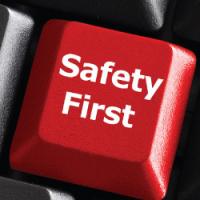- Posts: 350
- Thank you received: 11
Ladder Inspections & Safety
- Safety Toolbox Talk Webmaster
-
 Topic Author
Topic Author - Offline
- Administrator
-

There are a reported 136,118 ladder related injuries in the United States annually! During 2008, work-related falls from ladders resulted in approximately 119 fatalities and an estimated 17,540 serious injuries.
Not all these incidents are due to defective ladders however that can certainly be one of the factors. It is important that ladders are inspected regularily. OSHA requires it in several instances.
OSHA 1910.25(d)(1)(x) -Ladders shall be inspected frequently and those which have developed defects shall bewithdrawn from service for repair or destruction and tagged or marked as "Dangerous, Do Not Use."
OSHA 1910.26(c)(2)(vi) - Ladders are to be inspected:
(c)(2)(vi)(a) If ladders tip over or
(c)(2)(vi)(d) If ladders are exposed to oil and grease
OSHA 1910.27(f) – Fixed Ladders -All ladders shall be maintained in a safe condition. All ladders shall be inspected regularly, with the intervals between inspections being determined by use and exposure.
These required frequent inspections must be documented. Perhaps the easiest way is to have stickers or tags directly on the ladder itself and to have a ladder log to ensure they are all inspected as required.
Unfortunately frequently is a very subjective word. Truly each ladder must be evaluated on it's use and exposure to damaging influences. You will want to inspect a ladder utilized daily that is in a high exposure area much more often then the office step stool used every now and then.
There are also rules for use of all ladders:
- Maintain ladders free of oil, grease and other slipping hazards.
- Do not load ladders beyond their maximum intended load nor beyond their manufacturer's rated capacity.
- Use ladders only for their designed purpose.
- Use ladders only on stable and level surfaces unless secured to prevent accidental movement.
- Do not use ladders on slippery surfaces unless secured or provided with slip-resistant feet to prevent accidental movement. Do not use slipresistant feet as a substitute for exercising care when placing, lashing or holding a ladder upon slippery surfaces.
- Secure ladders placed in areas such as passageways, doorways or driveways, or where they can be displaced by workplace activities or traffic to prevent accidental movement. Or use a barricade to keep traffic or activity away from the ladder.
- Keep areas clear around the top and bottom of ladders.
- Do not move, shift or extend ladders while in use.
- Use ladders equipped with nonconductive side rails if the worker or the ladder could contact exposed energized electrical equipment.
- Face the ladder when moving up or down.
- Use at least one hand to grasp the ladder when climbing.
- Do not carry objects or loads that could cause loss of balance and falling.
Although ladders are part of our everyday life at both work and home, it's important we don't take them for granted. Ensure you inspect and utilize ladders appropriately.
Please Log in or Create an account to join the conversation.
- Justin Webber
- Offline
- New Member
-

- Posts: 1
- Thank you received: 0
Please Log in or Create an account to join the conversation.
- Andrew Chakanetsa
-

- Visitor
-

Please Log in or Create an account to join the conversation.
